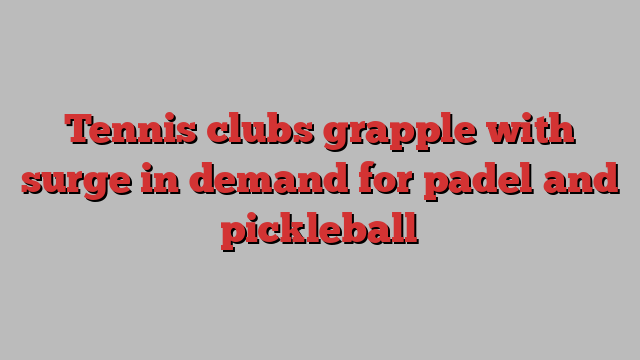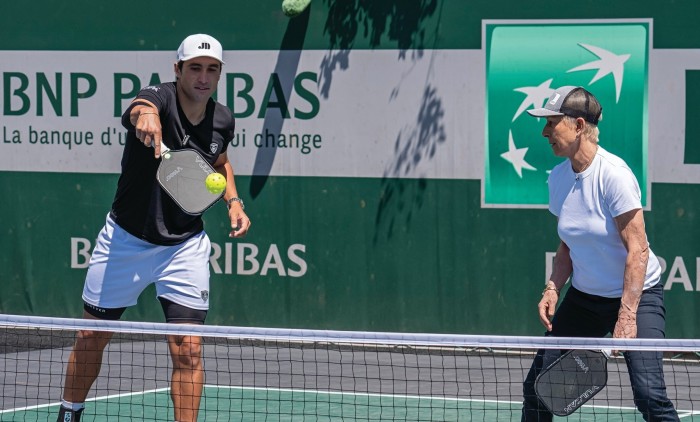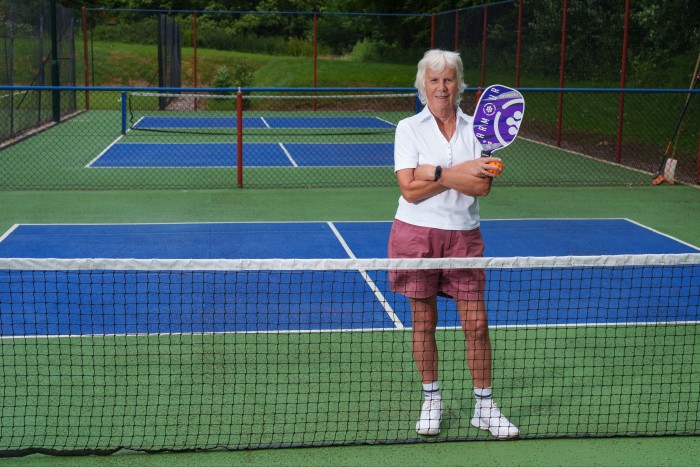
Although it was the first Grand Slam to join the “Open” era of professional tennis in 1968, Roland Garros has often been the last to adapt to changes in the sport. While the main show courts at the Australian Open, Wimbledon and the US Open had all been fitted with retractable roofs by 2016, Court Philipe Chatrier gained one only in 2020. And where players in Melbourne, London and New York have long made use of “hawk-eye” technology to challenge line calls, in Paris it still falls to umpires to decide.
But the move, four days before this year’s tournament ended, to transform court number 5 into three pickleball courts was a sign of how organisers are moving with the times.
The surge in demand for new racket sports is also visible at grassroots level in the UK. Together, padel and pickleball are reshaping traditional lawn tennis clubs as they seek to strengthen their post-pandemic financial positions and attract, and retain, members of all ages.
Padel and pickleball have well-established fan bases in Spain and the US, respectively. Invented a few years apart, in the 1960s, the sports are played on smaller courts and with smaller rackets and paddles than tennis. Padel uses the same scoring system as tennis while combining elements of tennis and squash. By contrast, pickleball mixes aspects of table tennis, tennis and badminton, and a game typically runs to 11 points.

Such differences have not proved a deterrent to take-up in Britain. Roughly 90,000 people were playing padel in November last year, up from just 6,000 in 2020, according to the Lawn Tennis Association, which oversees tennis in Britain. Among padel’s attractions are its social aspect — players form doubles teams — and its ease of playing, with no overarm serving and more opportunities for long rallies. Meanwhile, pickleballEngland, the governing body for the sport in England, puts the number of players at 30,000, little over a decade after the first British courts opened.
Individual tennis clubs across the country have been racing to accommodate the increase in demand. Grahame Robb, co-chair of the padel committee at Winchester Racquets and Fitness, said high booking rates for two padel courts that were installed by autumn 2020 quickly led to a third. All three are now almost always in use.
“Padel membership has increased by 285 per cent, to 203 people, in two years and we’ve had to freeze it,” he says, noting that the club overall had about 2,200 members. “The catchment area is phenomenal: people travel from as far as Plymouth [a city 30 miles away] to play.”
Robb — who used to play squash, racquetball and tennis but now calls himself a padel “addict” — says his committee had presented a business case to the club for building three more courts, which is under consideration.
However, incorporating the new sport has been “a challenge”, he admits, after opposition from some members who wanted the club, which has 15 tennis courts, to remain focused on the traditional game.
Even so, he says investing in padel makes financial sense for clubs still dealing with the fallout from the Covid-19 pandemic, when curbs on social activities hit revenue.
“I would say that padel definitely will increase the financial stability of any tennis club,” he explains. “The returns are higher and, depending on how you fund the courts — whether it is through court fees or membership fees — probably you get at least between three and four times the revenue from a padel court than a tennis court.”
Some clubs will be more “risk-averse”, he thinks, and “probably hope that private padel member clubs set up and they’ll just go away. I don’t think that’s going to happen; if tennis tried to close out padel, it would backfire”.
Ben Nichols, founder and chief executive of specialist consultancy Padel 22, estimates that the average UK padel court generates about £50 per hour and says tennis clubs can introduce padel “without sacrificing or compromising their history”.
“It doesn’t need to be an ‘either-or’,” he argues. “We all respect the UK is a racket sports nation. That should be embraced, but new opportunities come along to embrace new members.”

In Mary Kirkpatrick’s case, it took “a bit of persuading” for fellow officers at Macclesfield Tennis Club, in the north of England, to agree to convert two disused junior tennis courts into pickleball courts, in late 2022.
Founded in 1905, the club had 41 pickleball members — out of an overall membership of 263 — at the end of last year, and the number was “increasing all the time”, says Kirkpatrick, who is president of the club and manages the new venture. “Anyone can play, and we’re getting more members than possibly we want, in the end.”
Kirkpatrick, who plays socially at least three times a week, says roughly one-third of people making inquiries about pickleball bought a membership, which costs £55 a year. The rest opted to pay £3 per session. Both fees are likely to increase soon. Current tennis members can play for free, she adds, which “should become quite an advantage to getting new members”.
Although Kirkpatrick acknowledges the potential financial benefits to the club, with three pickleball courts fitting into the space of one tennis court, she dismisses the idea of it “booting out tennis”.
“Pickleball members who play regularly say we need more courts . . . but we’d need a complete reorganisation that I can’t see happening. It would upset too many people,” she says.
Nichols also points out that the UK is a long way behind the US in providing facilities, and the challenge of finding land and then obtaining planning permission to construct courts presents a bigger obstacle to the development of padel than Britons’ fondness for traditional tennis.
Ultimately, he sees the sports as complementary. “They are getting more non-racket players picking up a racket,” he observes. “Padel players are moving into tennis as much as the other way round. A rising tide lifts all boats.”